“The M2 Pioneer is a pilot’s watch,” Gustavo Calzadilla, Tutima’s U.S. president, told me. “It’s not meant to be a diver’s watch.”
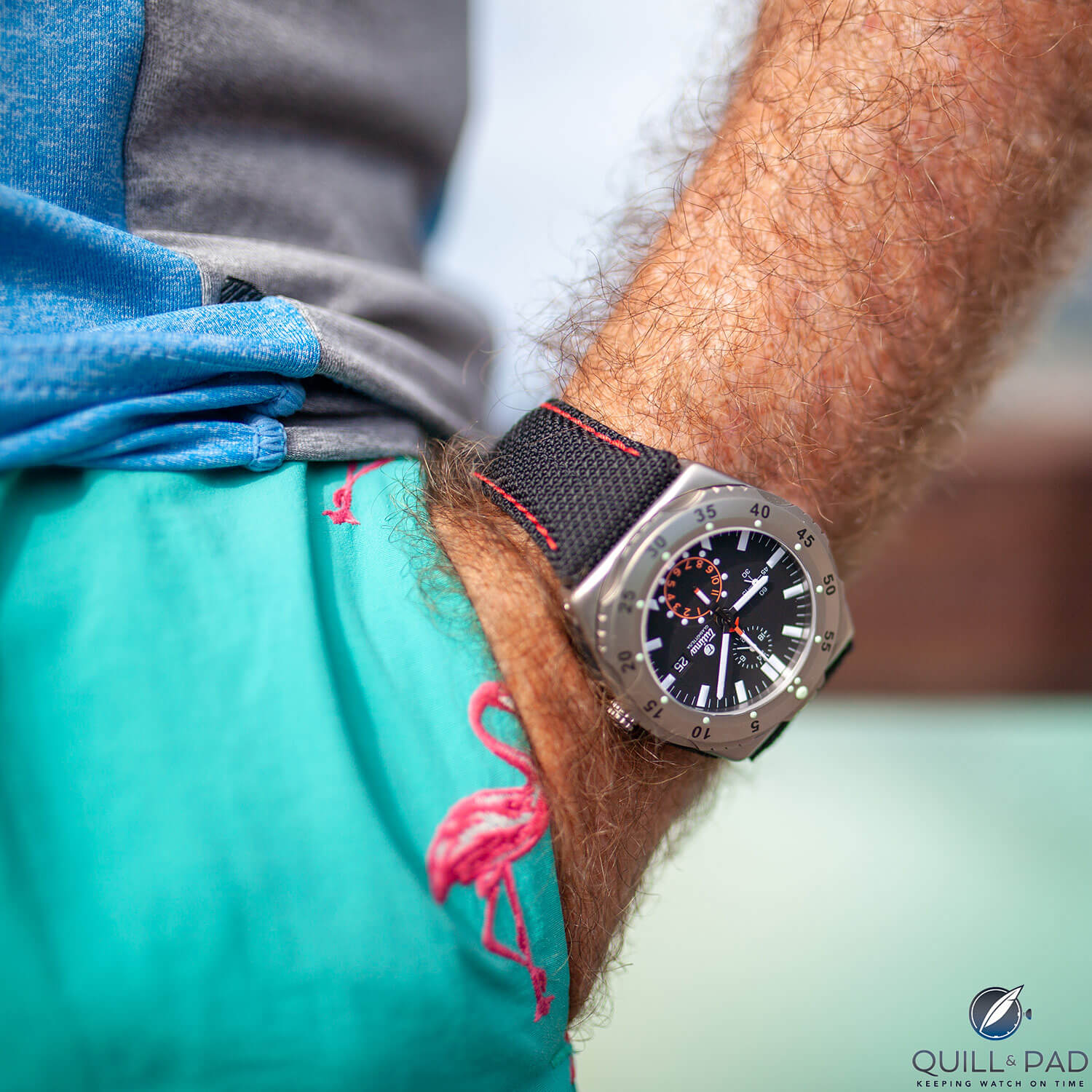
Tutima M2 on the author’s wrist in Bora Bora (photo courtesy Sadry Ghacir)
“True,” I countered. “But how often do watch fans ever get into the cockpit or strap on a scuba tank and jump into a 30-degree, gin-clear lagoon?”
Yet that’s exactly what I had in mind for the M2. I wanted to see what would happen if I were to re-purpose this storied pilot’s timepiece as a lifestyle watch.
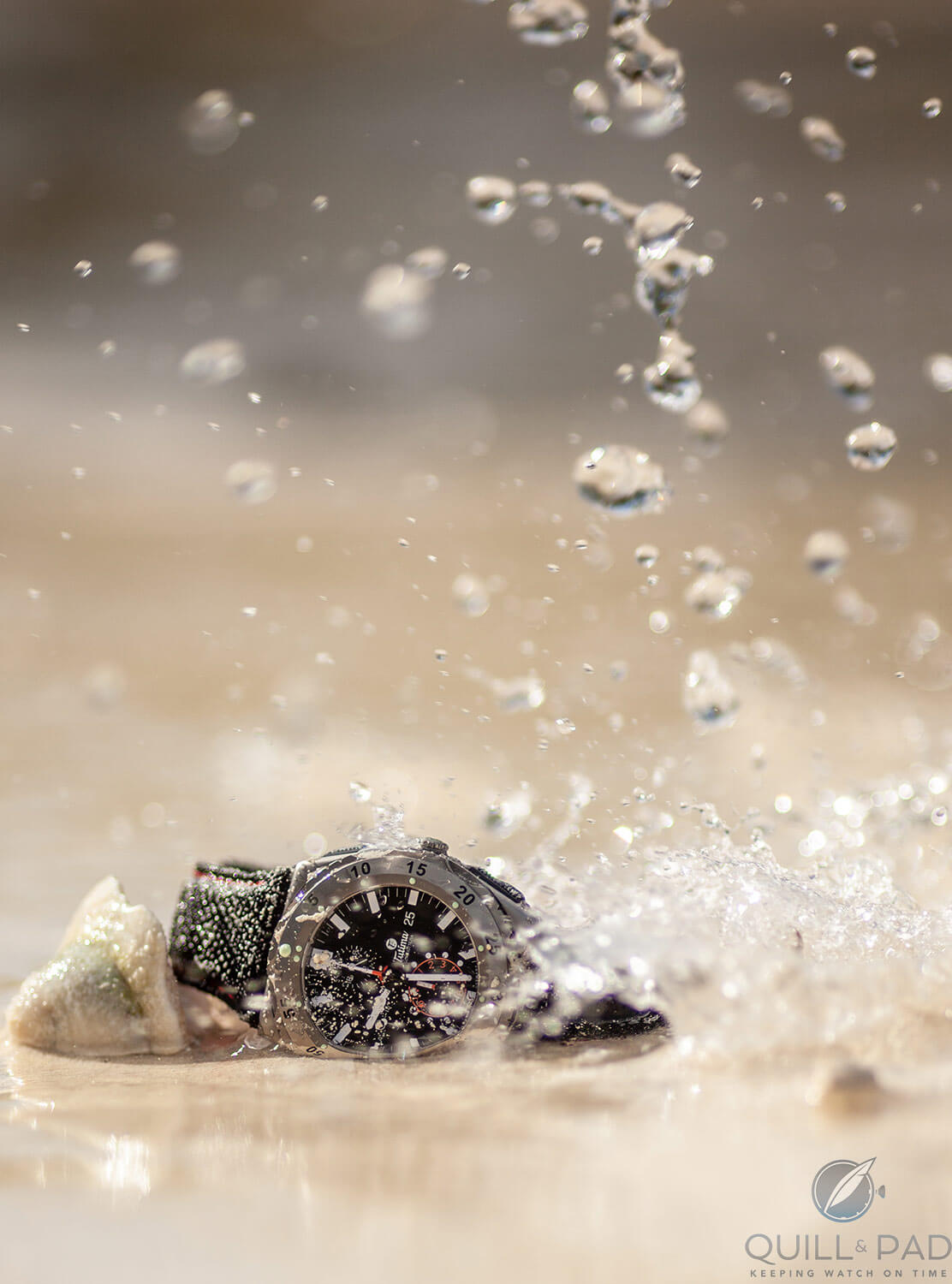
Tutima M2 getting wet on the Bora Bora beach (photo courtesy Sadry Ghacir)
I found myself going to Bora Bora . . . so I decided to see how the M2 performs under a variety of conditions for which it was never really designed but in which most of us would be far more likely to participate.
While in Bora Bora I subjected the M2 to all there is to do on this idyllic island. I snorkeled its crystalline lagoon, I dived its beautiful reef, kayaked all over, did stand-up paddle boarding for the first time, windsurfed, kite surfed (10/10 on the difficulty scale), sailed, and took it to dinner on the beach.
The M2 baked in the brilliant sunshine right along with me. It went for hours on end caked in salt water and sand. Here’s what I discovered about the M2 Pioneer.
Tutima M2 Pioneer: a robust timepiece
The M2 is one serious watch. The manufacturer calls it a professional-grade time-measuring instrument without compromises or extraneous design features. For those familiar with my taste in “working man’s watches” (see The Tool Watch Revolution: Utilitarian Goes Upmarket), you know that’s what excites me. There is true beauty in perfectly engineered functionality.
That’s how I’d describe Tutima’s M2: the watch has everything that’s needed to fulfill its mission and nothing more. Perfect.
The travel industry has transitioned from luxurious vacations to adventure trips often designed to test one’s mettle. Few would bring their five-figure Rolexes or elegant Patek Philippes along for paddle boarding, kayaking, diving, or kite surfing.
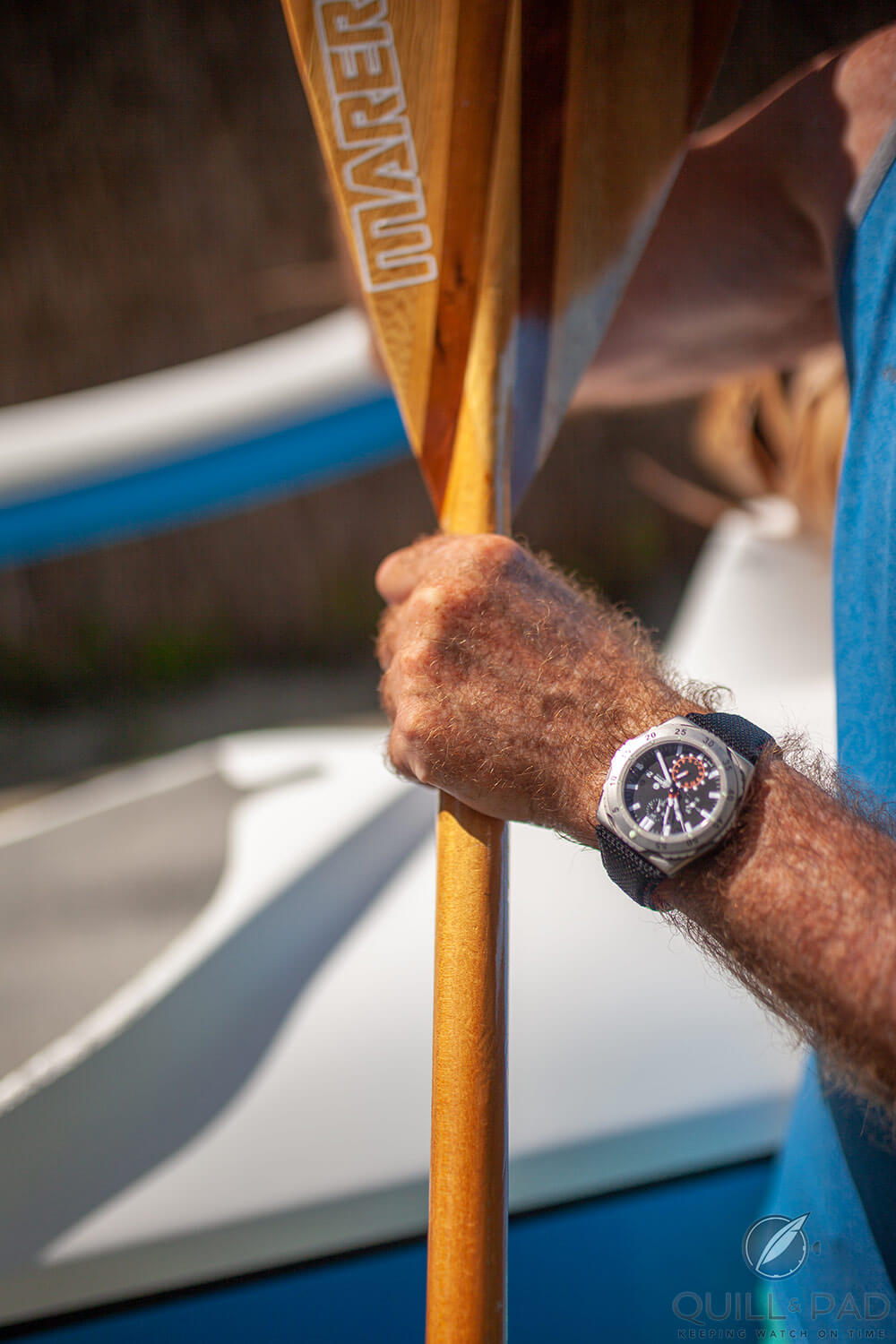
Tutima M2 kayaking (photo courtesy Sadry Ghacir)
I found myself on Bora Bora doing all these things and more with the M2. It was a reliable, indestructible companion through it all; I didn’t think for even a second about babying the piece.
As for signs of wear, there really wasn’t any on the bead-blasted titanium case. The two-button safety-folding clasp securing the Kevlar strap has a small scratch from a run-in with an underwater rock, though. And the titanium case color seems slightly grayer from all the time spent in salt water and the blazing sunshine of French Polynesia. I love the worn-in appearance the piece now has.
The M2 Pioneer’s heritage
Tutima’s M2 Pioneer is based on mil-spec requirements from the 1984 chronograph the company built for the German military. When Tutima released the piece to the public it kept, and in many cases enhanced, the original specifications related to magnetic resistance, shock resistance, vibration and acceleration to 7Gs in any direction, and depth rating (300 meters/1,000 feet).
The watch was indeed designed to be flown up to the edge of the envelope for those few piloting high-performance military aircraft. Why stop there? The rest of us can use this over-engineered marvel for so much more.
Materials used in the Tutima M2 Pioneer
Tutima has now substituted titanium for the stainless steel used in the 1984 military issue. Then the brand bead-blasted the titanium so it would be less prone to scratching (which I proved).
The decision to change from stainless steel to titanium probably cut the overall weight of the piece in half. As far as I know, Tutima includes the Kevlar strap with the titanium bracelet for $6,700 (those wanting just the strap will pay $6,100). The strap and bracelet are interchangeable with the tool provided.
The case back is solid titanium, and I’d have been surprised to see an exhibition case back on such a robust and rugged watch. The good news is that it is beautifully engraved, a bi-plane marking the M2 heritage of pilot’s watches and their designed purpose.
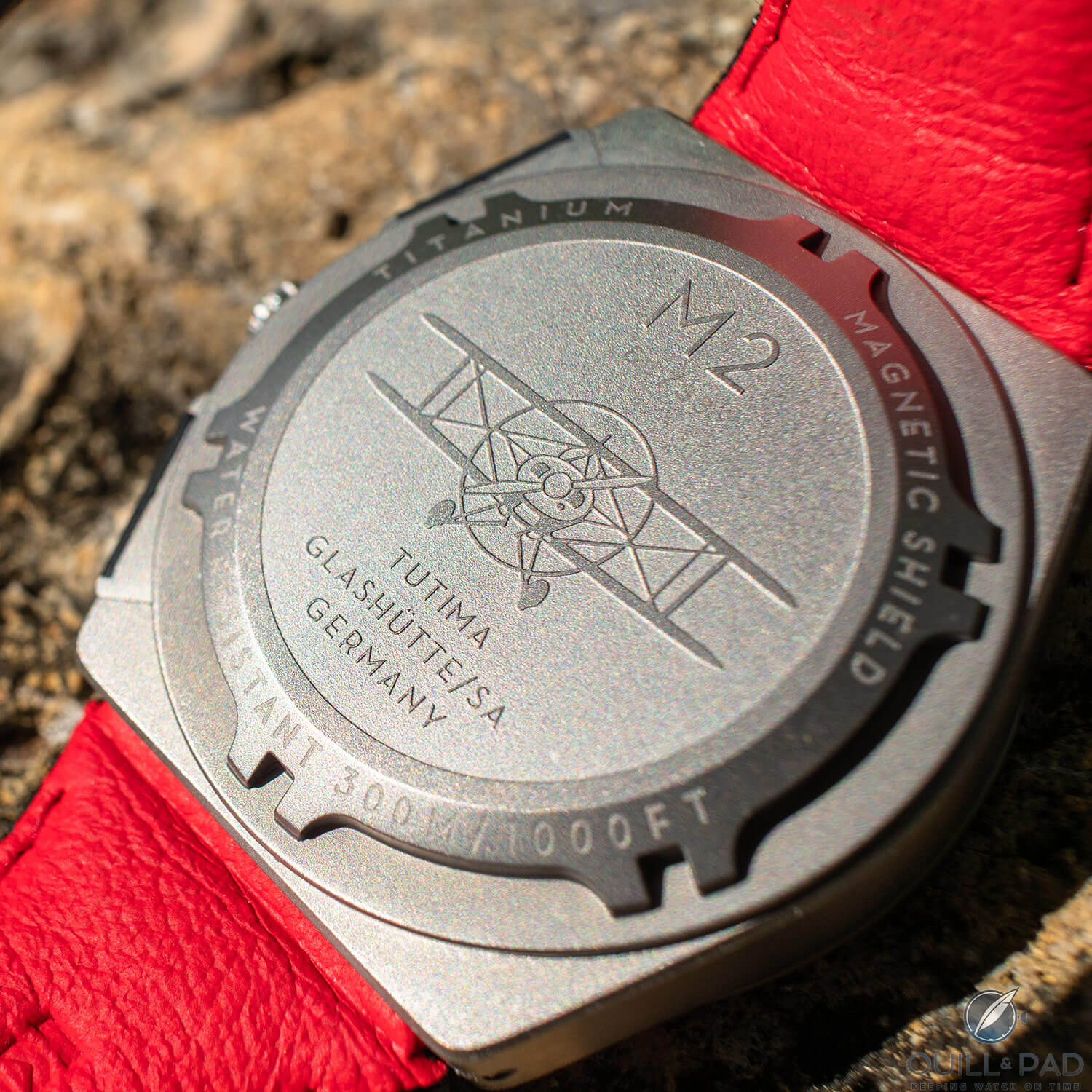
Tutima M2 from the back (photo courtesy Sadry Ghacir)
Additionally, there’s an inner casing of mu-metal, a nickel-iron alloy binding magnetic field streams so that they do not even reach the movement.
Probably good for pilots, but for us lifestylers not essential.
Though my test piece was on a Kevlar strap, I can see the benefits of changing to the bracelet. The black Kevlar strap has a spiffy red leather lining; however, it’s worth noting that the red dye in the leather ran a little after a soaking.
The Kevlar strap adds a bit more bulk to the watch than I imagine the bracelet would. This makes it hard to imagine the 46 mm timepiece under a shirt cuff. But over a wetsuit, absolutely.
The sapphire crystal is 4.3 mm thick – plenty of security to help provide that 300-meter depth rating in case you wish to take it diving. Which I did. Its double-sided anti-glare coating preserved legibility under all conditions – and these were many and varied.
Interacting with the Tutima M2 Pioneer
They say the dial is the “face” of the watch. If that’s so, the M2 has one serious face that I found both beautiful and fully functional.
The black matte finish has a velvet appearance, making it the perfect backdrop for the white markers and hands (all seven of them) on the brightest of sunny days. The date window at 3 o’clock almost appears as part of the dial – but a part that advances each day.
The emerald glow of Super-LumiNova all over the hands and five-minute dot markers on the bezel are perfectly visible at night or in whatever dark places your lifestyle finds you.
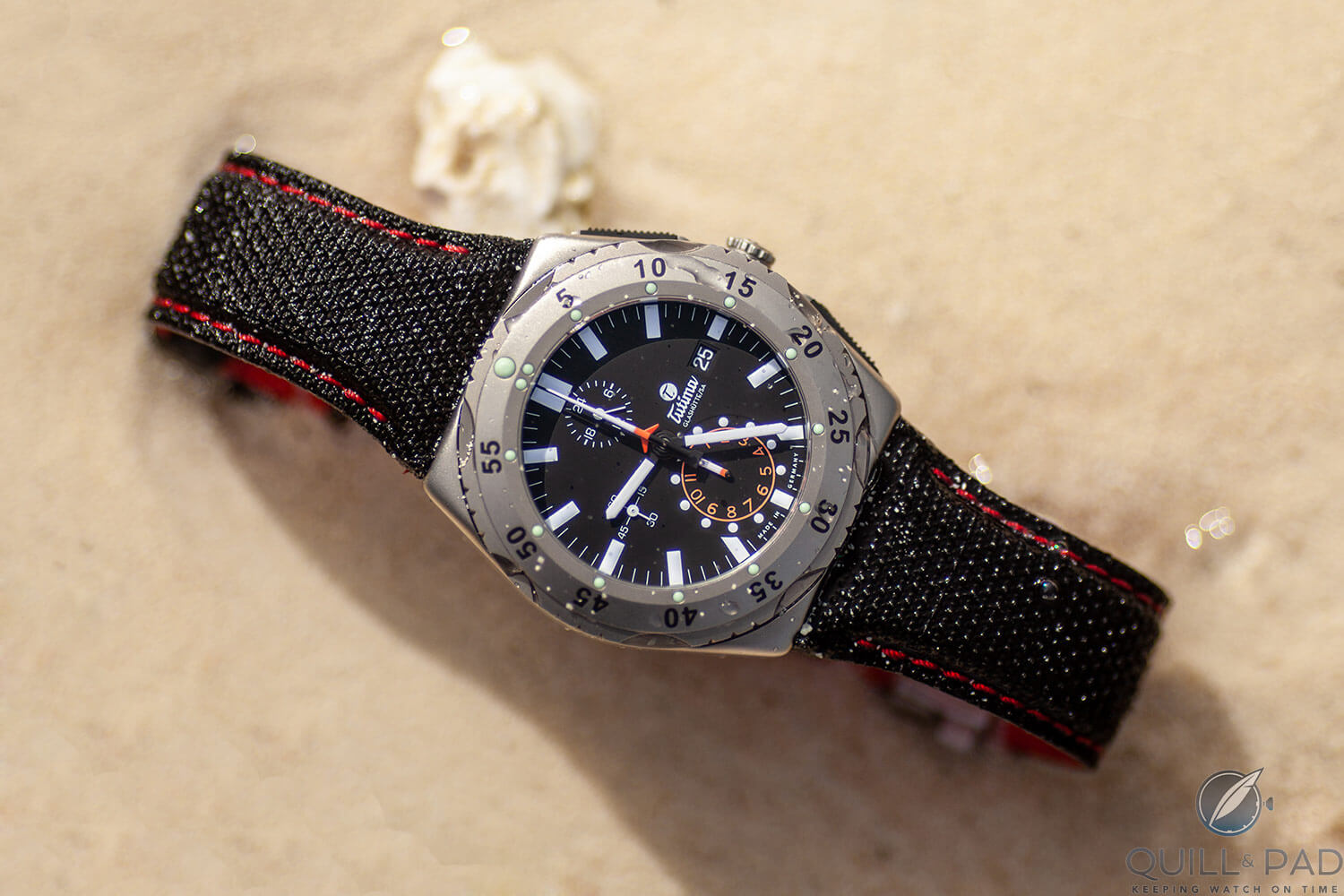
Tutima M2 Pioneer (photo courtesy Sadry Ghacir)
The dial’s hour and minute hands are the biggest since timekeeping is the M2’s primary mission. The watch was accurate for my purposes, losing only about 45 seconds in total during my week on Bora Bora (and putting it well within the official chronometer specs of the C.O.S.C.).
The two sweep chronograph hands (minutes and seconds) provide a more dominant display than the subdials of most chronographs and take some getting used to since they are almost identical.
The differences between them are twofold: the second hand is the one that’s always moving when the chronograph is active and the minute hand has orange swept wings at its base (the second hand is painted orange at its base, no wings).
Once you get used to it, there’s no mistaking which chrono hand is which. Timing events (like the minutes to tack on a reach while windsurfing) are a breeze.
The third chronograph display is the 12-hour subsidiary dial at 6 o’clock. This large subdial is outlined in orange with orange numerals and a white triangle at the 12 position.
These three components – hours, minutes, and seconds – make up the timing component of the M2 chronograph.
The dial’s 9 o’clock position has a small continuously running second hand whose subdial is graduated in 15-minute intervals. This function exists more to see that the watch is running than for any other useful purpose. It has no luminous paint on the hand.
I used it to set the watch to the exact second by stopping the watch when the second hand reached 60, then setting the minutes and hours, and then waiting for the actual time to catch up with my set time before pressing the crown in and restarting the watch.
At 12 o’clock there’s a 24-hour subdial that converts the central time to a 24-hour scale. The 24-hour hand does not have any luminous paint on it, owing to its lesser status.
The bezel rotates bidirectionally; it is marked in five-minute increments with 60 one-minute click detents. The knurls and indents provide for a good grasp on the bezel.
A good thing too since this is the stiffest rotating bezel I’ve encountered. Anyone would be hard pressed to accidentally move this bezel from its intended setting regardless of what they might be doing with the watch.
My conclusion is that if the bezel’s bi-directionality and lack of any minute markers are all that disqualifies the M2 from being a dive watch, then fear not. I had no reservations taking the watch to depth for a lovely dive on Bora Bora’s reef.
The screw-in crown is an ingenious bit of engineering as it screws right into the case. So rather than add shoulders to protect the crown, the surrounding case serves the same purpose. However, I found the small size of the crown protruding from the case on such a robust watch presented a small issue.
When I received the M2 from the manufacturer, the crown was screwed so tightly into the case that it was not possible to gain sufficient grip with my fingertips to unscrew it to set the time. I am told by another Tutima owner that such stiffness is an anomaly. It could have simply been an enthusiastic tech making sure the sample given me was watertight.
I confess to resorting to my trusty needle-nose pliers (never travel without them). With this small issue behind me and the watch now precisely set, I made sure not to crank the crown down any more than finger tight.
Another issue with the tiny crown was winding. The winding stem – like the rotating bezel – was quite stiff on this sample. For me it was not possible to wind the watch using the crown. No problem. I just rotated the watch in a circle a few times each morning to be sure it was sufficiently wound. I could hear and feel the rotor rotating as the watch wound.
During the week I had the M2, it never stopped so I didn’t have reason to use the crown again. I am told that such stiffness probably recedes after a few cycles of using the crown.
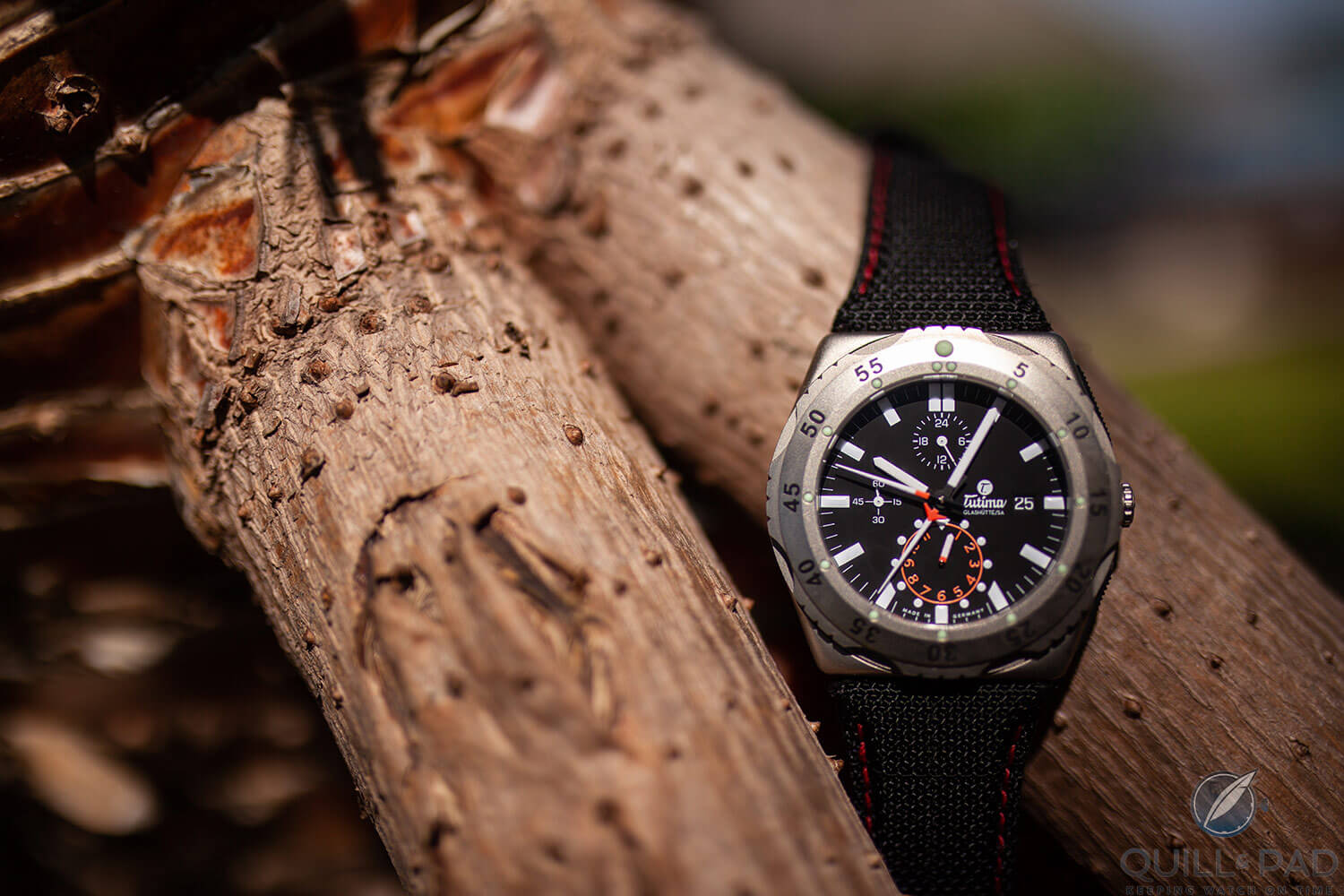
Tutima M2 Pioneer (photo courtesy Sadry Ghacir)
Surprisingly, I used the chronograph functions quite a bit. Activating the chrono was a breeze with Tutima’s pushers. First, unlike so many other manufacturers, these are hinged. You’re pushing a lever, which is much more accurate and reassuring. The M2 follows normal convention: the top pusher starts the chronograph, the bottom pusher stops it.
Additionally, the pushers have a neoprene face so there’s no skidding of wet fingers across the pusher. The throw of the pushers is satisfyingly firm so as to prevent accidental activation.
I found the bottom pusher took some getting used to in order to reset the chronograph, discovering the best position to press it was right next to the crown and to press it firmly all the way to its stop. This ensured a complete reset that didn’t leave the second hand hanging out somewhere other than 12 o’clock (reset position).
Tutima certainly knew that there would be some (like me) who might insist on taking the M2 underwater. Though the company doesn’t recommend using the pushers underwater, it equipped them with an ambient pressure sensor.
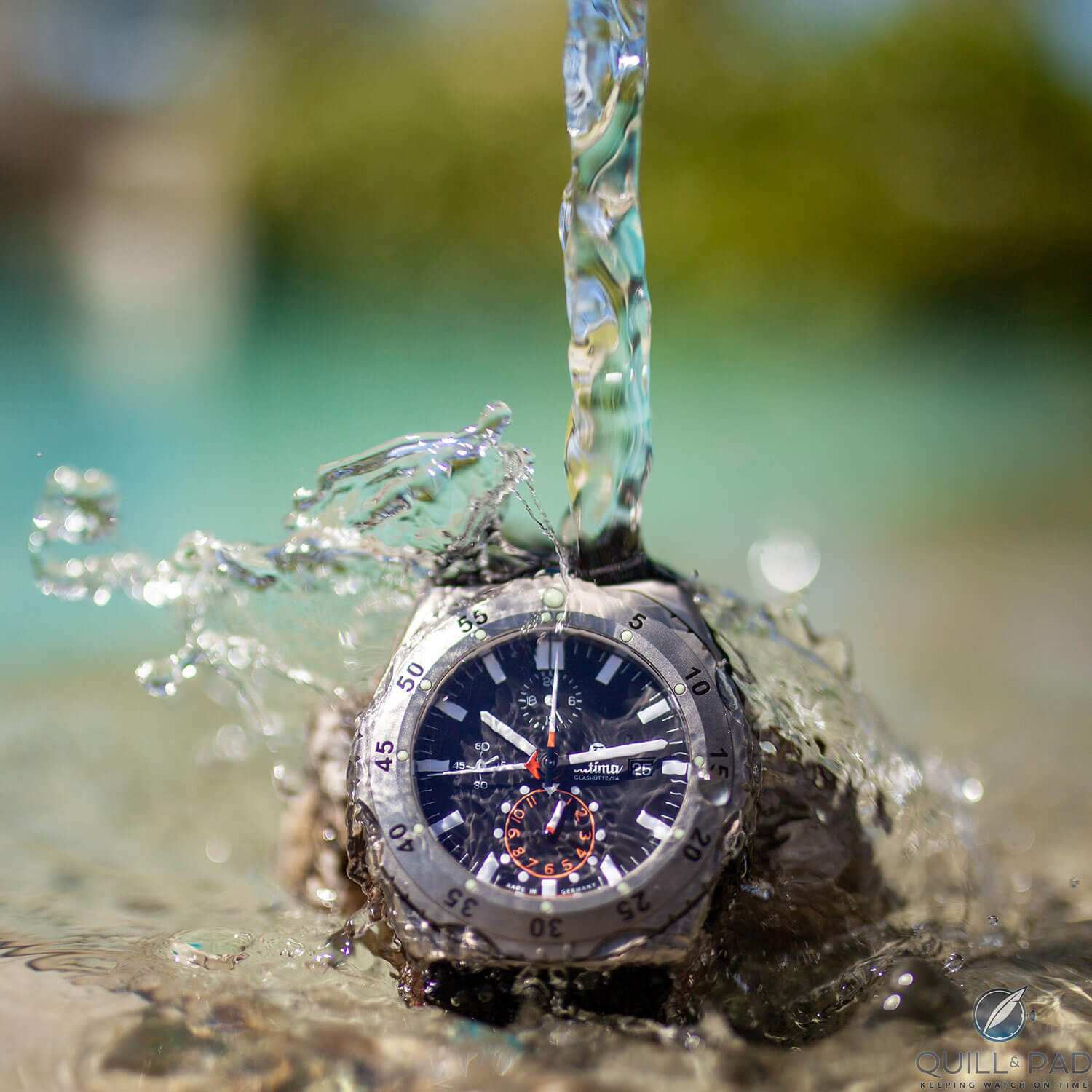
Tutima M2 Pioneer (photo courtesy Sadry Ghacir)
Water pressure greater than that found at 100 meters intentionally deactivates the pusher function. My conclusion is that you could probably use the M2’s chronograph function for sport diving (to depths less than 120 feet), but why would you? Today’s dive computers are the primary instruments anyway, and a watch is just a redundancy.
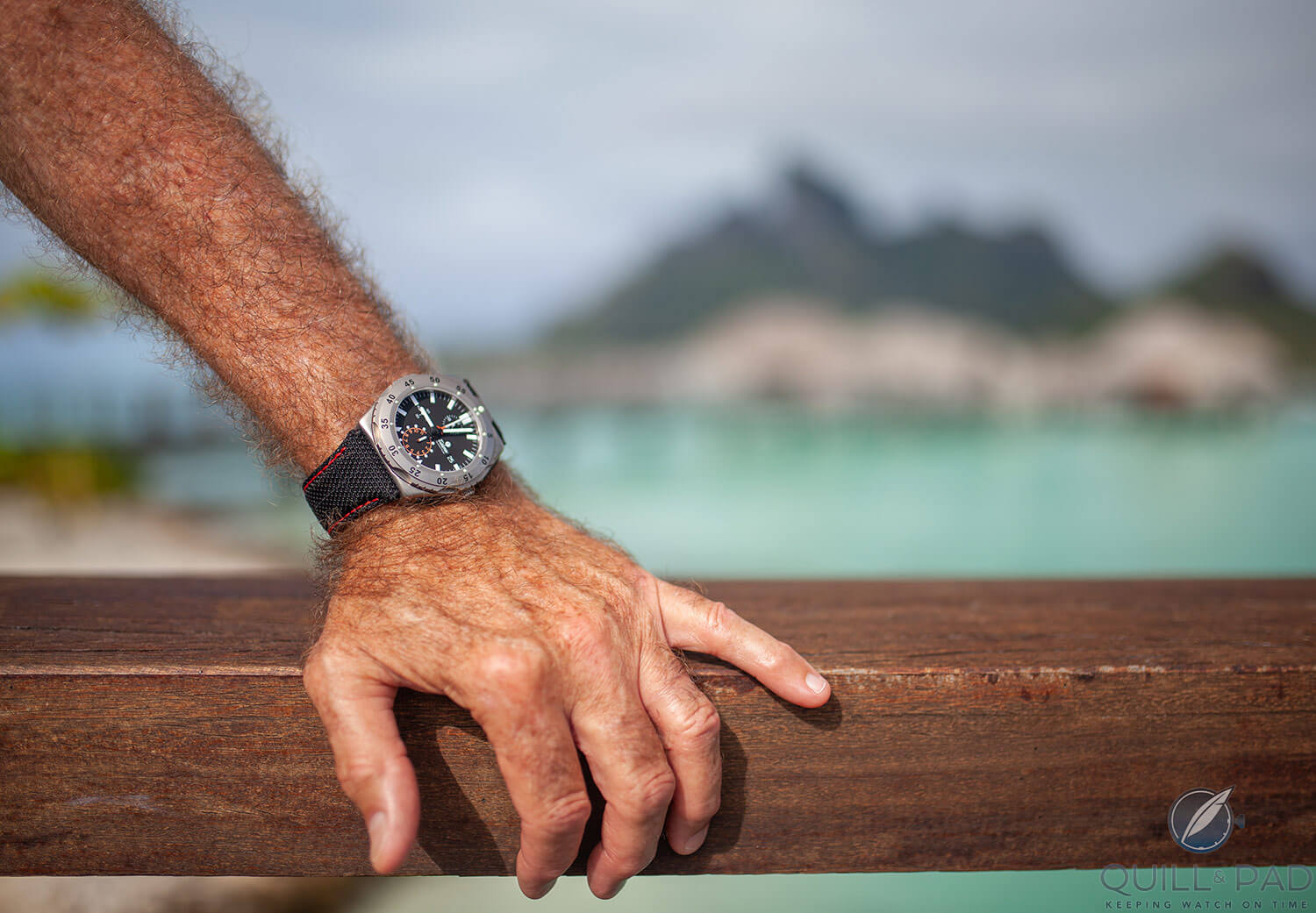
Tutima M2 on the wrist in Bora Bora (photo courtesy Sadry Ghacir)
M2 Pioneer: lifestyle fit?
While I I don’t feel that the M2 Pioneer is a daily-wear watch, I’d love to have such a robust and functional timepiece in my collection. It is a watch you can rely on with total confidence. It won’t scratch, and you don’t have to worry about knocking it against objects that would tear lesser timepieces asunder.
To me, that’s the definition of a lifestyle watch – one that seamlessly integrates into your life without undue thought or attention required regardless of activity. It’s right there when needed and retreats into the background when not.
For more information please visit www.tutima.com.
Quick Facts Tutima M2 Pioneer
Case: 46.5 x 16 mm, bead-blasted titanium, double-sided anti-glare coating, solid titanium case back; water resistant to 300 meters
Movement: automatic Tutima Caliber T 521, 4 Hz/28,800 vph frequency, 44-hour power reserve
Functions: hours, minutes, small seconds; date, chronograph, 24-hour indicator
Price: $6,100 with Kevlar strap; $6,700 with titanium bracelet and strap
You may also enjoy:
The Tool Watch Revolution: Utilitarian Goes Upmarket
Here’s Why: The Chronograph Is The New Tourbillon
90 Years Of Tutima: An Abbreviated, Complete History
Tutima Tempostopp Flyback Chronograph: A Moving Homage To The History Of Glashütte
Leave a Reply
Want to join the discussion?Feel free to contribute!





















































Tutima build 3 models for NATO Pilots and later on private user:
Ref. 798 in 1984 as stainless steel modell, introducing the design and well known as the “NATO Chronograph”
Re. 760 in 1995 with the same design, but made out of titanium
Ref. 750 in 1997 with a bidirectional bezel and titanium
They are the real predecessors of the actual M2 Chronograph series, Tutima is just reopening their treasure box, while in 2013 they wanted to get rid of that stuff.
Please do not forget Ref. 629, same shape, made of titanium and called DI 300, where DI means Diver
which is the predecessor of the M2 Seven Seas and what you test, when looking for the ultimate “working man’s watch” with a all over pragmatic design instead of Bi-planes and chichi-screw connection on the back.
7k for this watch … those days are behind us.